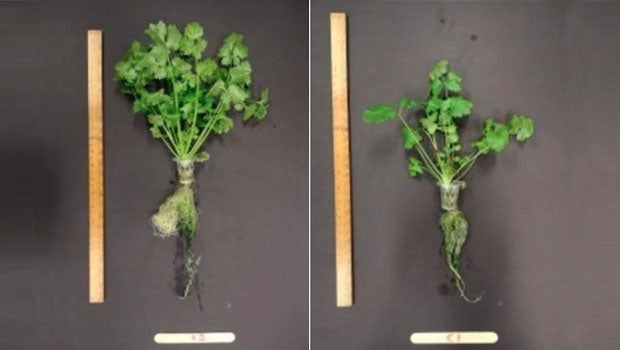
Coriander grown from seeds that were sent to space (left) had a more luxuriant yield at 41.4g, compared to its hydroponically grown earthbound counterpart, at 33.1g. PHOTOS: SFA
SINGAPORE – Singaporeans could one day enjoy crisp salads made with vegetables that got “upsized” in outer space.
In 2021, the island state sent coriander seeds to the International Space Station – an orbiting laboratory about 400km from Earth – as part of an Asia-Pacific project. Eleven countries contributed 22 herb seed types stored in a ziplock bag, to find out how space travel affects them.
While an astronaut’s health must be safeguarded from the harsh space environment, the coriander seeds more than held their own, turning into “superseeds” during their month-long stint in space.
When planted back on Earth, the seeds boasted a more luxuriant yield, weighing 41.4g versus their earthbound counterpart’s 33.1g.
Space radiation and microgravity – the condition of being weightless – led to genetic mutations in the seeds that could generate random but potentially useful traits, said the Singapore Food Agency in a joint reply with other institutions involved in the project.
The other institutions are Singapore Space and Technology, the Agency for Science, Technology and Research’s Genome Institute of Singapore (GIS), and the SingHealth Duke-NUS Institute of Biodiversity Medicine (BD-MED).
Scientists from GIS and BD-MED who conducted genetic analysis on the plant’s leaves, roots and stem found that hundreds of genes involved in biological processes associated with plant growth were activated in different ways, compared with ordinary plants.
“This suggests that changes in gene expression due to space exposure could produce tangible differences in plant yield,” said the organisations in a joint reply.
More studies will be carried out to understand the effect of space flight on the genes and DNA of plants, they added.
They will also explore the potential of space-induced breeding of seeds to create hardy next-generation crops and new vegetable varieties.
Such crops could boost food security since they can be resilient to diseases and harsher climates.
China has been doing space breeding of seeds since the 1980s. This process involves sending seeds to space and germinating them back on land. More promising crops are bred further until researchers obtain their ideal plant, according to a BBC report on China’s space breeding endeavours.
BBC also reported that China has developed more than 200 space-mutated crop varieties over three decades, which include rice, corn, soya bean and watermelon.
The Asia-Pacific project that Singapore was involved in is called Asian Herb in Space (AHiS), initiated by the Japan Aerospace Exploration Agency.
Ms Gillian Chin, Singapore’s point of contact for the project, said: “The purpose of AHiS is to provide students and young researchers in the Asia-Pacific region an opportunity to learn about space biology.” Apart from Singapore, the other countries that contributed seeds include Australia, Bangladesh and Indonesia.
But things are not all dull for earthbound seeds. Scientists have been dabbling in gene-editing technologies to increase the nutrients in lettuce or make bok choy grow faster, for instance.
Commenting on the Singapore project, Dr Naweed Naqvi, senior investigator at the Temasek Life Sciences Laboratory, said exposing seeds to space radiation to create mutations is economically not feasible, and its impact can be broad, uncontrolled and non-specific.
But he noted that some radiation, such as gamma rays, is routinely used in plant research to generate mutations and understand plant growth and reproduction.
Dr Naweed added: “Gene editing is much more precise and clean. It is less time-consuming and based on prior knowledge of the specific gene targets or pathways to be manipulated.”
Professor Yu Hao, head of the National University of Singapore’s Department of Biological Sciences, said: “For developing sustainable ways of producing supercrops, the application of space radiation could be tried, but its actual effects – compared with gene editing and other mutation approaches that could be easily performed on Earth – need to be further investigated.”













 Get it on Google Play
Get it on Google Play